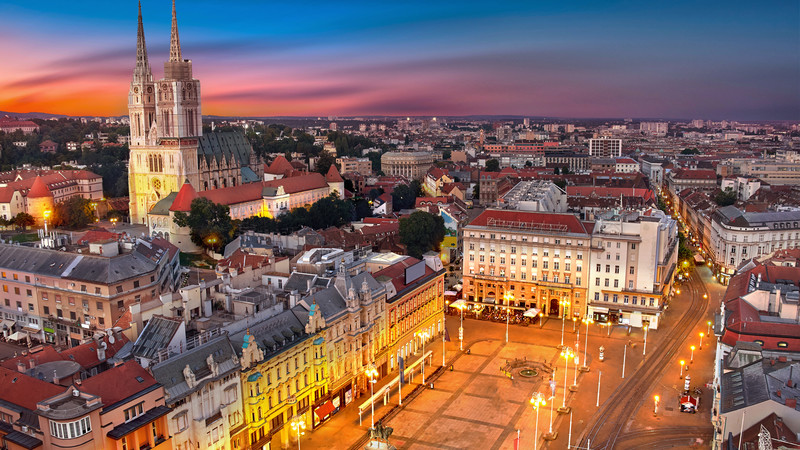Small Wonder: Zagreb punches above its weight

Croatia’s vibrant capital is a small, sophisticated city often overshadowed by Adriatic superstars such as Dubrovnik and Split. But a new international airport means Zagreb has come into its own as Croatia’s main gateway, connected by air to over 50 cities. Tourists are discovering a very laid back metropolis with stunning architecture, fascinating museums and an engaging bar and café lifestyle. It’s no surprise that Zagreb was Lonely Planet’s ‘Best in Europe’ as recently as 2017.
After arriving in the early afternoon at my apartment accommodation in the city’s centre, I head straight to Zagreb’s hub, Ban Jelacic Square. On the way I walk through streets with numerous crowded outdoor cafes. I’m rushing to see as much of this city as possible in the 48 hours before I leave for the coast, but the atmosphere of relaxed, friendly socialising here makes me slow down. I’m liking the place already.
Ban Jelacic Square is the city’s meeting point. People are alighting from nearby trams that traverse the city. Friends are meeting here before going to restaurants, bars and theatres. Families and businessmen stroll past the imposing statue of Josip Jelacic, seated on a horse with sword drawn. Jelacic was a nineteenth-century governor who came to symbolise Croatian independence after fighting a losing battle with Hungary. I gaze at the beautiful nineteenth-century buildings bordering the square before crossing on my way to the striking twin spire cathedral nearby. Then I head west and further into the upper town.
The upper town is a precinct of charming ancient streets leading to the Stone Gate, an entrance to the medieval area of the city. The Stone Gate doubles as a pilgrimage site where people come to pay homage to a seventeenth-century painting of the Virgin and Child, supposedly the only section of a wooden gate that survived a fire in 1731. On the way up to St Mark’s Church from here I pass a crowd of nuns, a group of Chinese tourists and some of the faithful making offerings. St Mark’s is the landmark church famous for its colourful tiled roof displaying a variety of coats of arms. Parliament house and the presidential palace are nearby.
I then walk down past the beautiful Jesuit Church of St Catherine to a point near the thirteenth-century Lotrscak Tower, where there’s a wonderful view of the city. The quaint funicular railway takes me on a short trip to the lower town.
Wandering past the monument to Nikola Tesla, one of Croatia’s famous sons, I head along the bustling street named after him past cafes and restaurants. Many of the eateries in this lower part of the city are those favoured by locals. There are also some attractive outdoor areas, such as the delightful Zrinjevac Park and the Botanical Garden.
Next morning, after a well-earned sleep, I grab a cheese burek (a filled filo pastry) and takeaway coffee from a nearby bakery and walk to the impressive Croatian National Theatre. Opened in 1895 and built in the Baroque Revival style, the National Theatre is the place to see opera and ballet in Zagreb.
The lower town also has many fine examples of Austro-Hungarian architecture and is worth walking around there for that reason alone. But a standout is Kallina House, a brilliant Art Nouveau structure known as the ‘Bat House’ because of its distinctive bat motif tiles that decorate the first floor windows.
It’s still early in the morning, so I catch a bus to Mirogoj Cemetery. This is a massive necropolis park, with magnificent entrance buildings and tree lined avenues. It’s a very peaceful place and compares favourably for atmosphere with Havana’s Necropolis Cristobel Colon and Buenos Aires’ Recoleta Cemetery.
After contemplating the afterlife, I make my way back to the city and the popular Museum of Broken Relationships. This unconventional storehouse of exhibits is a crowd-sourced collection of artefacts and stories related to ‘brokenships’ or ‘the way we love and lose’. Each personal object symbolises a relationship breakdown and is accompanied by a narrative about how the relationship ended. It’s quirky, fascinating and often poignant. You may want to buy a ‘bad memories eraser’ at the museum’s shop.
But I know I’ll only have good memories of Zagreb. It’s won my heart in two days and I’ll definitely want to hook up with this enticing city again.
The writer travelled at his own expense.
Fact File:
Getting there: Emirates and Qatar fly direct to Zagreb (ZAG)
When to Go: May to September.
Where to Stay: Five star apartments in Zagreb starting at $75 per night are available online.
Eat:
Time Pastry Shop – Ulica Nikole Tesle 14, Zagreb 10000
La Struk restaurant, Skalinska ul. 5, Zagreb 10000.
Bistro Fotic, Gajeva Ulica 25, Zagreb 10000
Nokturno Restoran, Skalinska ul. 4 , Zagreb 10000


You must be logged in to post a comment Login